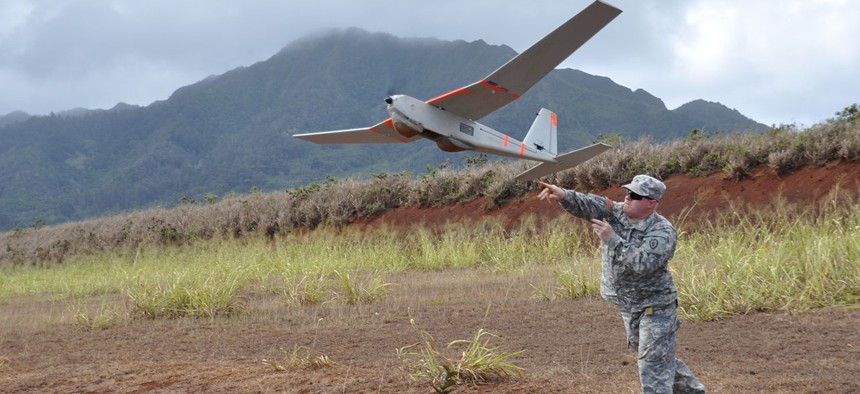
The U.S. Army has two rucksack-portable drones, including the hand-launched Puma shown here. The service is looking to procure a smaller, shorter range UAV as soon as next year. Army file photo
The Army’s Next Drone May Fit in a Soldier’s Pocket
The service could start buying palm-sized UAVs to complement its Pumas and Ravens as soon as 2018, according to one official.
The U.S. Army may become the latest service to dabble in micro UAVs, with a plan to invite bids to supply a short-range micro (SRM) drone as early as 2018, said Col. Courtney Cote, the Army’s project manager for unmanned aircraft systems.
Other services are already exploring the possibilities afforded by smaller, lower-cost drones, from autonomous tactical UAVs to swarming drones shot out of a fighter jet’s flare dispensers. The Army itself has long flown variations of the hand-launched Raven, which essentially defined the service’s small-UAV program in its early days, Cote said. More recently, the program has added the longer-range Puma, also by AeroVironment.
“The Army went back and wrote a requirements document that said we need a family of small UASs ... that gives a tactical commander some options for how they use it, how that capability gets delivered,” he said. “So what that requirement document did is it defined the long-range, the Puma; a mid-range which is the Raven, which we already had; and then that short-range micro which is to be defined, and to be pursued.”
Taken together, the family of small drones will support “the varied reconnaissance needs of the battalion-level and below echelon” and will improve interoperability between ground vehicles and other unmanned sensors, according to the Army’s Unmanned Aircraft Systems Roadmap for 2010-2035. But funding for the SRM program is not yet assured amid an Army drone portfolio that also includes the larger Shadow and Gray Eagle UAVs, Cote said. In fact, before Christmas, the Army is also set to have the first flight test for an improved version of the latter, Cote said.
That may sound like a lot, but Russian-backed infantry and artillery units have used more than 16 types of drones over the battlefields of eastern Ukraine. The U.S. Army is, of course, developing counter-drone technologies and will soon publish its Counter UAS Strategy. But the service is also moving to emulate that flexibility.
The Army wants its battalions and companies to be able to draw from the family of small drones based on its function or mission.
“Depending on what type of unit you are, you might get two Pumas, three Ravens, and one SRM,” Cote said. It will vary if “you’re an engineering unit, infantry unit, armor unit, mech unit. Different equipment sets are defined, so you’ll get that kit that gives you options to coordinate based on what the Army expects you to do.”
Longer term, the Army wants to add another tactical UAV as an alternative to the Shadow, which Cote said is now flying at almost twice the weight of the original version. Rather than just upgrading to a larger engine, the Army’s looking at developing a new UAV.
“We’re starting to get into [questions like]: If you’re going to put a bigger engine on it, are you going to put a bigger engine on the same platform?” he said. “How do get more sensors? How do you create more options for the operational commander, the brigade combat team? And then the Army also has to answer some questions: Do they want the brigade combat team commander to have an armed UAS, which the Shadow obviously isn’t. Is that a capability we expect the BCT commander to be able to employ at that echelon?”
Though there’s an initial capabilities document for the UAV floating around the Pentagon, Cote said answering those questions will take until the 2020s.
NEXT STORY: The Russian Hack of the DNC







